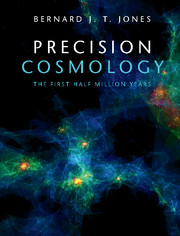Book contents
- Frontmatter
- Dedication
- Contents
- Preface
- Notation and Conventions
- Part I 100 Years of Cosmology
- Part II Newtonian Cosmology
- 5 Newtonian Cosmology
- 6 Dark Energy Cosmological Models
- 7 The Early Universe
- 8 The Inhomogeneous Universe
- 9 The Inflationary Universe
- Part III Relativistic Cosmology
- Part IV The Physics of Matter and Radiation
- Part V Precision Tools for Precision Cosmology
- Appendix A SI, CGS and Planck Units
- Appendix B Magnitudes and Distances
- Appendix C Representing Vectors and Tensors
- Appendix D The Electromagnetic Field
- Appendix E Statistical Distributions
- Appendix F Functions on a Sphere
- Appendix G Acknowledgements
- References
- Index
6 - Dark Energy Cosmological Models
from Part II - Newtonian Cosmology
Published online by Cambridge University Press: 04 May 2017
- Frontmatter
- Dedication
- Contents
- Preface
- Notation and Conventions
- Part I 100 Years of Cosmology
- Part II Newtonian Cosmology
- 5 Newtonian Cosmology
- 6 Dark Energy Cosmological Models
- 7 The Early Universe
- 8 The Inhomogeneous Universe
- 9 The Inflationary Universe
- Part III Relativistic Cosmology
- Part IV The Physics of Matter and Radiation
- Part V Precision Tools for Precision Cosmology
- Appendix A SI, CGS and Planck Units
- Appendix B Magnitudes and Distances
- Appendix C Representing Vectors and Tensors
- Appendix D The Electromagnetic Field
- Appendix E Statistical Distributions
- Appendix F Functions on a Sphere
- Appendix G Acknowledgements
- References
- Index
Summary
The evidence that the cosmological constant, Λ, is non-zero is overwhelming: the cosmic expansion is accelerating. Whether or not this is due to Einstein's famous constant, or some variant of it, i.e. ‘dark energy’, it is the major constituent of the Universe. Currently, we know almost nothing about it. The dominance of Λ, or whatever it is, at redshifts z < 1 means that we can study it via its effect on the cosmic expansion. The Newtonian models provide a good framework for modelling the expansion at these recent times, though we have to remember that we cannot study the propagation of light in the Newtonian context without importing some relativistic concepts.
A particularly relevant model is the ‘benchmark model', which is geometrically flat and contains both pressure-free matter and a cosmological constant. This model, and its generalisations to more exotic forms of dark energy, lie at the basis of the interpretation of modern cosmological data. We study it here via the Friedmann–Lemaître equations that describe the evolution of the Hubble expansion rate, H(z). We then move onto generalising the simple constant Λ to simple models for redshift-dependent dark energy.
As in the previous chapter, the exercises here serve as diversions that fill in details.
The Accelerating Cosmic Expansion
Important Remark
The evidence for the existence of an agent that causes the acceleration of the cosmic expansion comes from several quite diverse sources of data: supernovae, the power spectrum of the CMB, the present day manifestation of primordial structures (‘BAOs’), large scale cosmic structure, to name but a few. Each of these pieces of evidence has received ample confirmation from repeated experiments by independent groups. These sources of evidence agree not only as to the existence of this agency, but also to its magnitude. Even though we have little or no idea what this agency is, its discovery surely stands as one of the great scientific milestones of the past century.
Information
- Type
- Chapter
- Information
- Precision CosmologyThe First Half Million Years, pp. 130 - 153Publisher: Cambridge University PressPrint publication year: 2017
